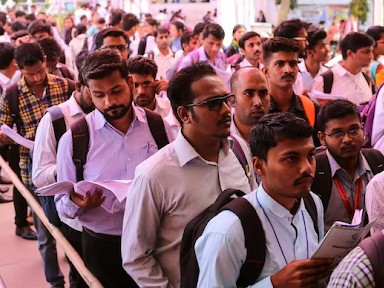New Delhi3 minutes ago
- Copy link

The unemployment rate was 5.6% in June last month.
India’s unemployment rate has come down to 5.2% in July 2025. This is the lowest in the last 3 months. The unemployment rate was 5.6% in June last month.
According to the Periodic Labor Force Survey of the Ministry of Statistics and Program Implementation, the number of jobs has increased the most in urban areas.
New industries, such as IT, Telecom, Manufacturing and Retail Sector, have above the graph of employment. Apart from this, recruitment has also increased in small and medium industries, due to which the level of employment in villages and towns has improved.
Unemployment rate at the lowest level in April
| month | Unemployment rate |
| april | 5.1% |
| May | 5.6% |
| june | 5.6% |
| july | 5.2% |
Unemployment rate of women higher than men
The unemployment rate in rural areas was 4.4%, while in urban areas it is 7.2%. This rate (8.7%) in women compared to men’s unemployment rate (4.6%), especially in urban areas. This data suggests that women in cities are facing more difficulty in finding employment than men.
What is unemployment rate?
The unemployment rate is the percentage that suggests how many of the people who have the desire and ability to work have not got jobs. That is, people who are looking for jobs, but they did not get work, are considered unemployed.
Suppose 100 people want to work and are looking for jobs. 5 of these people did not get jobs. So unemployment rate will be 5%. The lower this rate, the more it means that more people are engaged in jobs or work.
How does the government measure it?
- The Government of India conducts the Periodic Labor Force Survey (PLFS) through the Ministry of Statistics and Program Implementation (MOSPI).
- People are asked from house to house in PLFs, such as they are working, looking for jobs, or do not want to work.
- The government counts those who are 15 years or older to withdraw unemployment rates. Are available to work. Are actively looking for a job, but did not get the work.
Increase in labor force participation rate (LFPR)
In July 2025, the labor force participation rate (LFPR) was 54.9% for individuals aged 15 and above. LFPR means the total number of people available or working to work. LFPR was higher in rural areas than urban areas. It was 56.9% in the village, while in urban areas it was 50.7%. Depending on gender, men’s LFPR (77.1%) was much higher than women’s 33.3%.
This data suggests that the number of people willing to work in rural areas is higher than in urban areas.
What is the labor force participation rate (LFPR)?
The labor power participation rate (Labor Force Participation Rate) is the percentage that suggests how many of the total population are working or looking for a job. That is, it is the proportion of people who are either engaged in work or unemployed, but are ready to work.
If 60 out of 100 people are working or looking for jobs, LFPR will be 60%. The higher it, the more it means that people are excited to work.
Worker-publicity ratio (WPR) also improved
In July 2025, labor population ratio (WPR) was 52.0% for individuals aged 15 and above. WPR states how many of the total population are actually in employment.
WPR in rural areas was 54.4%, which is more than 47.0% of urban areas. In rural areas, women WPR was 35.5%, while in urban areas it was 23.5%. This shows that women’s participation in workforce in rural India is higher than urban women.
What is a worker-ratio ratio (WPR)?
Worker-population ratio (worker-papulation ratio) is the percentage that suggests how many of the total population are working. This includes jobbers and self -employment (eg shop, farming, or freelancing).
Suppose there are 100 people in a village and 50 of them are doing jobs or any work, then WPR will be 50%. The higher it is, the more it means that more people are in employment.



